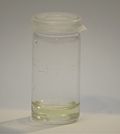The autoignition temperature or self-ignition temperature, often called spontaneous ignition temperature or minimum ignition temperature (or shortly ignition...
8 KB (528 words) - 12:51, 14 August 2024
Flash point (category Threshold temperatures)
confused with the autoignition temperature, the temperature that causes spontaneous ignition. The fire point is the lowest temperature at which the vapors...
10 KB (1,185 words) - 15:49, 25 February 2024
the autoignition temperature of the hazardous atmosphere. Both external and internal temperatures are taken into consideration. The autoignition temperature...
31 KB (3,010 words) - 12:25, 14 July 2024
Most ordinary human activity takes place at temperatures of this order of magnitude. Circumstances where water naturally occurs in liquid form are shown...
41 KB (1,298 words) - 12:08, 14 August 2024
Smoke point (section Temperature)
point Combustion Drying oil Flash point Fire point Kindling point (Autoignition temperature) American Oil Chemists' Society (2011). "AOCS Official Method Cc...
8 KB (1,399 words) - 18:18, 14 July 2024
completing the fire triangle, usually by heating tinder above its autoignition temperature. Fire is an essential tool for human survival and the use of fire...
20 KB (2,284 words) - 12:31, 12 August 2024
unstable and tends to explode. When placed in vacuum, it has an autoignition temperature of 270 °C instead. With a melting point of 12.8 °C, the chemical...
40 KB (4,200 words) - 15:27, 14 August 2024
volatility to improve its carburetion characteristics and high autoignition temperature to prevent preignition in high compression aircraft engines. Turbine...
62 KB (6,715 words) - 03:54, 31 July 2024
monoterpene and can be distilled without decomposition, although at elevated temperatures it cracks to form isoprene. It oxidizes easily in moist air to produce...
19 KB (1,534 words) - 12:36, 2 August 2024
Activation energy asymptotics Chemical kinetics Mean kinetic temperature Autoignition temperature Quantum tunnelling "Activation Energy". www.chem.fsu.edu...
19 KB (2,150 words) - 22:08, 3 June 2024
point R-410A should not be mixed with air (oxygen) under pressure Autoignition temperature Difluoromethane: 648 °C; pentafluoroethane is fire-retardant...
14 KB (1,341 words) - 10:13, 15 August 2024
internal combustion engines because of its low 160 °C (320 °F) autoignition temperature. Diethyl ether is distinct from petroleum ether (a crude oil distillate...
6 KB (736 words) - 23:47, 2 November 2023
fuels such as gasoline, it is in many ways safer due to its higher autoignition temperature and its low density, which causes it to dissipate when released...
16 KB (2,367 words) - 21:19, 5 December 2023
between the autoignition temperature of paper and the date of the September 11 attacks; one of the film's taglines was "The Temperature at Which Freedom...
65 KB (5,863 words) - 17:09, 16 August 2024
β-hydroxyketones. Triethylborane is strongly pyrophoric, with an autoignition temperature of −20 °C (−4 °F), burning with an apple-green flame characteristic...
12 KB (1,020 words) - 11:19, 9 June 2024
Storing it as liquid takes less space than storing it as a gas at normal temperature and pressure. However, the liquid density is very low compared to other...
14 KB (1,358 words) - 13:23, 27 June 2024
mercury(II) fulminate can begin at temperatures as low as 100 °C, though it proceeds at a much higher rate with increasing temperature. A possible reaction for...
7 KB (568 words) - 09:10, 17 July 2024
near-simultaneous ignition of material caused by heat attaining the autoignition temperature of the combustible material and gases in an enclosure. Flashovers...
10 KB (919 words) - 22:54, 1 August 2024
range in violence from deflagration through detonation. Limits vary with temperature and pressure, but are normally expressed in terms of volume percentage...
26 KB (1,829 words) - 15:38, 19 July 2024
Cotton (section Critical temperatures)
210 °C (410 °F) Autoignition temperature: 360–425 °C (680–797 °F) Autoignition temperature (for oily cotton): 120 °C (248 °F) A temperature range of 25 to...
115 KB (13,146 words) - 14:39, 19 July 2024
heating which rapidly accelerates to high temperatures) and finally, autoignition. It is distinct from (but has similar practical effects to) pyrophoricity...
14 KB (1,690 words) - 11:44, 1 July 2024
hazards toxic NFPA 704 (fire diamond) 1 1 0 Flash point Nonflammable Autoignition temperature N/A Lethal dose or concentration (LD, LC): LD50 (median dose) >10000...
20 KB (2,025 words) - 01:08, 10 August 2024
and high-temperature applications. It is not recommended for use in flooded applications. R-422C is for use in medium- and low-temperature applications...
24 KB (1,742 words) - 09:19, 15 August 2024
(T) and dangerous for the environment (N). The gas is flammable (autoignition temperature: 651 °C) and can form explosive mixtures with air (16–25%). The...
137 KB (14,830 words) - 15:28, 29 July 2024
majority of the exposed surfaces in a space are heated to their autoignition temperature and emit flammable gases (see also flash point). Flashover normally...
7 KB (900 words) - 22:59, 1 August 2024
cyclic carbonate ester of ethylene glycol and carbonic acid. At room temperature (25 °C) ethylene carbonate is a transparent crystalline solid, practically...
10 KB (835 words) - 07:24, 31 July 2024
NFPA 704 (fire diamond) 3 2 1 Flash point 71 °C (160 °F; 344 K) Autoignition temperature 300 °C (572 °F; 573 K) Explosive limits 7.0% (low), 73% (high)...
5 KB (454 words) - 20:19, 11 April 2024
Product loss by decarboxylation to benzoic acid is common. The high temperature diminishes oxygen solubility in an already oxygen-starved system. Pure...
20 KB (1,883 words) - 10:21, 30 June 2024
critical. Testing of the fire point is done by open cup apparatus. Autoignition temperature Flash point Steven A., Treese; Peter R., Pujado; David S. J., Jones...
2 KB (185 words) - 19:40, 16 June 2024
NFPA 704 (fire diamond) 1 2 0 Flash point 43 °C (109 °F; 316 K) Autoignition temperature 333 °C (631 °F; 606 K) Except where otherwise noted, data are given...
4 KB (227 words) - 19:55, 14 December 2023



















